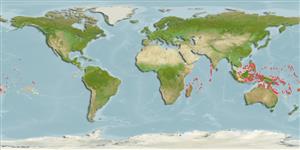>
Gobiiformes (Gobies) >
Gobiidae (Gobies) > Gobiinae
Etymology: Macrodontogobius: Greek, makros = great + Greek, odous = teeth + Latin, gobius = gudgeon (Ref. 45335).
Eponymy: Dr Ray Lyman Wilbur (1875–1949) was an American physician who became the third President of Stanford University (1916–1943), which had awarded his BA (1896) and MA (1897), and the 31st US Secretary of the Interior (1929–1933) appointed by Hoover. [...] (Ref. 128868), visit book page.
More on author: Herre.
Environment: milieu / climate zone / depth range / distribution range
Ecologia
marinhas; estuarina associadas(os) a recifes; intervalo de profundidade 0 - 20 m (Ref. 48637), usually 1 - 10 m (Ref. 90102). Tropical; 15°N - 30°S
Indo-Pacific: Seychelles eastward into Oceania, including Micronesia, Fanning, and Phoenix islands.
Tamanho / Peso / Idade
Maturity: Lm ? range ? - ? cm
Max length : 6.5 cm SL macho/indeterminado; (Ref. 48637)
Espinhos dorsais (total) : 7; Raios dorsais moles (total) : 9 - 11; Espinhos anais: 1; Raios anais moles: 9 - 10; Vértebras: 26. Ground color of dorsal part of body greenish brown, ventral whitish yellow; a black spot at base of caudal fin; 7 dark brown blotches longitudinally arranged in mid-lateral area; black spots on cheeks and operculae, one ventral to the eye; pectoral fins hyaline; white pelvic fins. Pigment intensity variable among localities. 7 or less predorsal scales. Large, ctenoid scales except for cycloid scales in isthmus (Ref. 403); pelvic fins united with well-developed frenum; rounded caudal fin, slightly longer than head; longitudinal scale series 27-31; fully scaled cheek and opercle; depth of body 4.6-6.3 in SL (Ref. 90102).
Inhabits coastal bays, lagoons and estuaries on fine sand along reef margins to about 20 meters depth (Ref. 48637). Solitary (Ref. 90102). Specimens collected from shallow waters to 7 m, near coral reefs. In southern Japan, the species inhabits sandy bay bottoms.
Life cycle and mating behavior
Maturidade | Reprodução | Desova | Ovos | Fecundidade | Larvas
Murdy, E.O., 1985. A review of the gobiid fish genera Exyrias and Macrodontogobius, with description of a new species of Exyrias. Indo-Pac. Fish. (10):14 p. (Ref. 403)
Categoria na Lista Vermelha da IUCN (Ref. 130435: Version 2024-2)
Ameaça para o homem
Harmless
Utilização humana
Ferramentas
Relatórios especiais
Descarregue XML
Fontes da internet
Estimates based on models
Preferred temperature (Ref.
123201): 25.4 - 29.3, mean 28.5 °C (based on 2331 cells).
Phylogenetic diversity index (Ref.
82804): PD
50 = 1.0000 [Uniqueness, from 0.5 = low to 2.0 = high].
Bayesian length-weight: a=0.01023 (0.00477 - 0.02194), b=3.01 (2.83 - 3.19), in cm total length, based on LWR estimates for this (Sub)family-body shape (Ref.
93245).
Nível Trófico (Ref.
69278): 2.8 ±0.4 se; based on diet studies.
Resiliência (Ref.
120179): Elevada, tempo mínimo de duplicação da população menor que 15 meses (Preliminary K or Fecundity.).
Fishing Vulnerability (Ref.
59153): Low vulnerability (10 of 100).
Nutrients (Ref.
124155): Calcium = 162 [79, 360] mg/100g; Iron = 0.94 [0.46, 1.78] mg/100g; Protein = 18.5 [16.5, 20.1] %; Omega3 = 0.157 [0.068, 0.304] g/100g; Selenium = 19.1 [9.4, 46.5] μg/100g; VitaminA = 138 [36, 473] μg/100g; Zinc = 2.94 [1.92, 4.37] mg/100g (wet weight);
